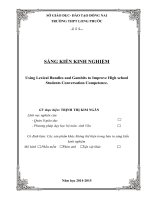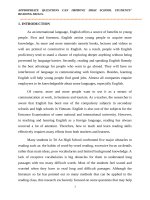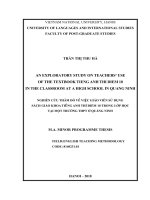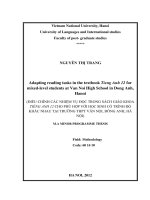skkn tiếng anh 11 using lexical bundles and gambits to improve high school
Bạn đang xem bản rút gọn của tài liệu. Xem và tải ngay bản đầy đủ của tài liệu tại đây (246.98 KB, 16 trang )
SỞ GIÁO DỤC- ĐÀO TẠO ĐỒNG NAI
TRƯỜNG THPT LONG PHƯỚC
…b & a….
SÁNG KIẾN KINH NGHIỆM
Using Lexical Bundles and Gambits to Improve High school
Students Conversation Competence.
GV thực hiện: TRỊNH THỊ KIM NGÂN
Lĩnh vực nghiên cứu
- Quản lí giáo dục
- Phương pháp dạy học bộ mơn: Anh Văn
Có đính kèm: Các sản phẩm khác không thể hiện trong bản in sáng kiến
kinh nghiệm
Mơ hình
Phần mềm
Phim ảnh
Hiện vật khác
Năm học 2014-2015
SỞ GIÁO DỤC VÀ ĐÀO TẠO ĐỒNG NAI
Đơn vị: THPT LONG PHƯỚC
___________________
Mã số: …………………..
SÁNG KIẾN KINH NGHIỆM
Using Lexical Bundles and Gambits to Improve High School Students Conversation
Competence.
Người thực hiện: Trịnh Thị Kim Ngân
Lĩnh vực nghiên cứu:
Quản lý giáo dục
Phương pháp dạy học bộ mơn
Phương pháp giáo dục
Lĩnh vực khác:
Có đính kèm:
Mơ hình
Phần mềm
Phim ảnh
Năm học: 2014-2015
Hiện vật khác
SƠ LƯỢC LÝ LỊCH KHOA HỌC
I. THÔNG TIN CHUNG VỀ CÁ NHÂN
1. Họ và tên: Trịnh Thị Kim Ngân
2. Ngày tháng năm sinh : 10/05/1980
3. Nam/Nữ: Nữ
4. Địa chỉ: Tổ 4, Ấp 1C, Xã Phước Thái – Huyện Long Thành –Tỉnh Đồng Nai
5. Điện thoại: 0913803522
6. Fax:
E-mail:
7. Chức vụ: Giảng dạy tiếng Anh
8. Đơn vị công tác: THPT Long Phước –Long Thành - Đồng Nai
II. TRÌNH ĐỘ ĐÀO TẠO
-
Học vị (hoặc trình độ chun mơn, nghiệp vụ) cao nhất: Cử nhân Tiếng Anh
-
Năm nhận bằng: 2004
-
Chuyên ngành đào tạo: Cử nhân chuyên ngành giảng dạy tiếng Anh
III. KINH NGHIỆM KHOA HỌC:
-
Lĩnh vực chun mơn có kinh nghiệm: Giảng dạy tiếng Anh
-
Số năm có kinh nghiệm: 6 năm
-
Các sáng kiến kinh nghiệm đã có trong 5 năm gần đây:
+ Xây dựng trường học than thiện, học sinh tích cực
+ Đổi mới phương pháp kiểm tra miệng
+ Increasing Grade 11 student’s Reading Comprehension by Using Different Types
of Questions.
Sở Giáo Dục & Đào Tạo Đồng Nai
CỘNG HÒA XÃ HỘI CHỦ NGHĨA VIỆT NAM
Đơn vị: THPT Long Phước
Độc lập - Tự do - Hạnh phúc
______________
Long Phước. ngày …... tháng …. năm…...
PHIẾU NHẬN XÉT, ĐÁNH GIÁ SÁNG KIẾN KINH NGHIỆM
Năm học: 2014-2015
Tên sáng kiến kinh nghiệm:
Using Lexical Bundles and Gambits to Improve High School Students Conversation
Competence.
Họ và tên tác giả: Trịnh Thị Kim Ngân
Đơn vị (Tổ): Tiếng Anh
Lĩnh vực:
Quản lý giáo dục
Phương pháp dạy học bộ môn
Phương pháp giáo dục
Lĩnh vực khác
1. Tính mới:
-
Có giải pháp hồn tồn mới
-
Có giải pháp cải tiến, đổi mới từ giải pháp đã có
2. Hiệu quả:
-
Hoàn toàn mới và đã triển khai áp dụng trong tồn ngành có hiệu quả cao
-
Có tính cải tiến hoặc đổi mới từ những giải pháp đã có và đã triển khai áp dụng
trong tồn ngành có hiệu quả cao.
-
Hoàn toàn mới và đã triển khai áp dụng tại đơn vị có hiệu quả cao
-
Có tính cải tiến hoặc đổi mới từ những giải pháp đã có và đã triển khai áp dụng tại
đơn vị có hiệu quả
3. Khả năng áp dụng:
-
Cung cấp được các luận cứ khoa học cho việc hoạch định đường lối, chính sách:
Tốt
Khá
Đạt
-
Đưa ra các giải pháp khuyến nghị có khả năng ứng dụng thực tiễn, dễ thực hiện và dễ
đi vào cuộc sống:
-
Tốt
Khá
Đạt
Được áp dụng trong thực tế đạt hiệu quả hoặc có khả năng áp dụng đạt hiệu quả trong
phạm vi rộng
Tốt
XÁC NHẬN CỦA TỔ CHUYÊN MÔN
(Ký tên và ghi rõ họ tên)
Khá
Đạt
THỦ TRƯỞNG ĐƠN VỊ
(Ký tên, ghi rõ họ tên và đóng dấu)
Research Title: Using Lexical Bundles and Gambits to Improve High School Students
Conversation Competence.
CONTENTS
1. Introduction
2. Description of school.
3. Students’ learning style and course books with limitation
4. Literature Review
5. Application: using conversation gambits/ lexical bundles in conversation
6. Conclusion
7. References
Introduction
The role of English in this century is incredibly powerful in all spheres of life . It is also true
that in Vietnam English plays an important role in many fields including education, business,
technology, banking, medicine, and tourism. It is the official language in a number of countries
in Asia and it is also the dominant business language. In fact, it is necessary for young people
to use it if they are to enter a global workforce. Research from all over the world shows that
cross-border business communication is most often conducted in English.
In business environments, English is a useful tool for exchanging information among
people from different cultures. We try to improve our conversational ability in order to express
our thoughts, our feelings and we can get ideas from others. In conversation, native English
speakers make use of lexical bundles and conversation gambits, so their spoken
communication becomes natural. As teachers of English, we should focus on the effectiveness
of conversations by increasing the use of bundles and conversation gambits. In my own
experience of teaching, I am aware that the main focus of learning English as a foreign
language is students’ communicative competence. The more opportunities they are given to
practice conversations in the classroom, the more effectively and fluently they can converse in
real-life situations. As an attempt to improve the teaching and learning of English for
communication, especially teaching and learning speaking skills, I will look at the
effectiveness of using lexical bundles and conversation gambits in teaching high school
students.
Description of School.
Long Phuoc High school which has thirty classes with over 1300 students each year, is
one of the biggest schools in Long Thanh District. This district has many industrial zones
where there are many foreign corporations and factories. Therefore, people in the district need
to use English to communicate with the foreigners and to find well-paid jobs.
In my school, each class has about forty students who are at different levels, some with
quite competent English, some whose English is not very good, while others whose English is
just getting started.
Students’ learning types and course books with limitations
We have used English 10, English 11 and English 12 as compulsory course books in the
curriculum, and we also know that the three books above have many good points and certain
limitations .The course aims, according to the curriculum, are to help the students develop the
four language skills: listening, speaking, reading and writing. In daily discussion with the
students, I know that they want to use English communicatively. However, in my own
experience of teaching, I have known that they have very few conversational strategies for
using the language, especially speaking skill. What they do in a speaking lesson is to copy
what the teacher already writes on the board and provided structures in the textbooks. They
find it difficult to produce their own sentences.
In reality, speaking skill is one of the most complex but crucial skill of the four language
skills for students learning English as a second or foreign language. Just think of the different
conversation you have in one day and compare that with how much written communication
you do in one day. In our daily lives most of us speak more than we write. However, most of
English teachers still spend the majority of class time on teaching reading and grammar
practice and almost ignore speaking and listening skills. This is also true for the teachers of
English at Long Phuoc High School, but the way in which they conduct the teaching of
speaking skills to students should be taken into consideration. Although they know the
importance of speaking, they’ve focused so much on grammar and correctness of the sentences
as it is a national examination for university entrance whose main focus is on reading and
writing. As a result, curricula and classroom teaching practices in academic high schools tend
to be organized or adjusted to improve those two skills and subsequently teaching speaking or
conversation skills has been considered secondary or relatively neglected although it figures
prominently in the national curriculum.
In addition, one of the most common ways for teachers to check students speaking is to repeat
the given structures in their text books, not produce sentences in their own words or their own
way based on these structures. It is usually very easy for students, so it doesn’t get students
motivated to speak out what they are thinking., however, they forgot to teach important skills
like getting a conversation starts, keeping it going, and ending it. Typical examples are: you
know, to begin with, I mean, right? Got it? Wait a minute……… It is believed that, if the goal
of your language course is enable your students to communicate in English, then speaking
skills should be taught and practiced in the language classroom.
It is therefore very
important that teachers be aware of the strategies and encourages students to make use of these
conversational strategies so that the students can enhance spoken discourse.
Moreover, dialogues are among the most materials used by language teachers. Scripted
dialogues in the three English textbooks used at high school usually consist of several short
exchanges between two people as follows
1. A: when was NewYork founded?
B: It was founded in 1624. And what about London?
A: It was founded in 43 A.D.
(E10, P159)
2. A: What kind of music do you like?
B: I like classical music.
A: Why do you like it?
B: Because it is relaxing.
(E10,Page 127)
3. A. When and where were the 1st Asian Games held?
B. they were held in 1951 in India.
A. How many countries took part in the Games?
B. eleven
A. How many sports were there at the Games?
B. Six
(E 11, page 139)
These kinds of dialogues are especially useful for introducing common expressions to
beginners. It helps them to develop some particular expressions and vocabulary that they can
use immediately. You may find, however, that these dialogues are not appropriate for the
reasons such as: the content of these dialogues aren’t real to life then students will not be
motivated to learn and the language used is not natural and authentic. The analysis of the
textbook dialogues shows that they fail to present learners with the way people actually speak.
Therefore, teachers and material developers should pay more attention to ways of providing
students with meaningful materials and content that allows them to engage in “real”
communication.
As a teacher, I would like to deal with common arguments against teaching speaking skills in
the classroom by using given dialogues. This study try to find out the answer to a key question:
“In what way teachers can provide Long Phuoc students with an opportunity to be exposed to
authentic conversation to develop their conversational proficiency where sufficient amount of
natural language input is not available from the context”. It is my expectation that the research
findings will help teachers in other schools makes an innovation in English teaching for the
communicative purposes. The first thing I would like to do in my study is to review literature
for the terms: lexical bundles and conversation gambits.
Literature Review
Lexical Bundles
While Conklin and Schmitt (2007) define that lexical bundles are groups of words that occur
repeatedly together within the same register. This definition depends on what constitutes a
group, how often these ‘groups’ recur and what exactly is a ‘register’. There is not universal
agreement on these points and so far, the perception of just what is a lexical bundle is open to
the individual’s own interpretation.
The term itself, lexical bundle, hasn’t met with broad acceptance. It is also called a recurrentor fixed-word combination, a multiword lexical chunk, a formulaic sequence, a lexical phrase.
The identification of lexical bundles is a relatively new field of study. Understanding lexical
bundles and using them is especially important to the English language learners because it
places the individual words within a larger context. When individual words are embedded
within different contextual environments they can take on different meanings. Being aware of
the broader potential of the individual word's meanings helps the language learners to integrate
and be creative when familiar words are used. When lexical bundles are incorporated into
regular language use, they can be called up together rather than as individual words. The
knowledge and use of these bundles saves on processing time and space and also can
encourage the use of the individual words included in the bundle.
While Conklin and Schmitt (2007) have dealt with what they call 'formulaic sequences' whose
definition is different from what is named a lexical bundle, they recognize the value of these
groups of words to language learners. As they note, "Non-natives rely on formulaic language a
great deal in their efforts to produce fluent speech".
The following box describes common lexical bundles native English speakers often use:
go on
of course
in terms of
in fact
at all
deal with
make sure
look for
end up
make sense
in other words you know
by the way in some way so far as
in general
as well as
and then
right away
I would say
after all
I don’t know
in case
or
whatever
you’re gonna more or less in order to/that
in a/any sense of/that
I mean for
sure/certain on the other hand
as well
Conversation Gambits
Richards (1993) points out that gambit is a remark intended to start a conversation or make a
telling point. In conversational analysis, gambit is sometimes used to describe a word or phrase
in conversation which signals the function of the speaker’s next turn in the conversation.
Gambits can be used to show whether the speaker’s contribution adds new information,
develops something said by a previous speaker, and expresses an opinion and agreement. The
lack of mastery of using gambits in maintaining the conversation leads to breakdowns in
speaking.
Keller (1981) stated that gambits make the conversation sound more natural, more confident,
and also make it possible to talk easier. It is obvious that conversation involves people taking
turn while speaking. Based on turn-taking rules- any listener might be selected to speak next.
In this case, the speaker need time to formulate his/her thoughts that react to what the previous
speaker has said at the same time. Hence, gambits can influence the process of turn-taking in
the conversation.
For example, gambits which signal that the speaker is going to express an opinion include:
The way I look at it……
To my mind…….
In my opinion…….
Other conversation gambits are used for hesitation, clarification, interruption, making
suggestion, asking for suggestions/advice, giving an opinion, expressing agreement and
disagreement. As teachers, we need to help students make good use of the following
conversation gambits as language functions in every speaking lesson so that they can find it
easy to start a conversation, negotiate ideas, meanings and finish a conversation in a natural
and effective way.
Hesitation:
Uh . . .
Well, um . . .
Let's see.
Let me think.
How should I put it?
That's a good question.
I'll have to think about that.
Clarification:
Sorry, but I don't see what you mean.
Could you be more specific?
Could you explain that in more detail?
Do you mean . . . ?
What do you mean by . . . ?
What I mean is . . . .
What I meant was . . . .
Let me put it (say it) another way.
What I'm saying is . . . .
Interruption:
Pardon/excuse me, but. . . .
Sorry/Excuse me for interrupting, but . . . .
May I ask a question?
I'd like to comment on that.
Making Suggestion:
May I make a suggestion?
Don't you think . . . ?
Wouldn't you say (agree or think) . . . ?
Asking for Suggestions/Advice:
Do you have any suggestions?
What do you think?
What would you do?
What should I do?
Giving an Opinion
I think. . . .
I believe . . . .
In my opinion, . . . .
As far as I'm concerned. . . .
Personally, I think . . . .
It seems to me that . . . .
Expressing Agreement and Disagreement
That's a good point.
I (completely) agree (with you).
That's true.
That makes sense.
I think so, too.
I couldn't agree more.
That's not how I see it.
I don't really agree with you.
I'm afraid I can't agree with you.
I'm not sure I quite agree with you.
Application: using conversation gambits/ lexical bundles in conversation
Original conversation 1.
A: Hi,Minh. Did you have a nice weekend?
B: Hello, Quan. Yes, I did. It’s great.
A: What did you do?
B: I went to Lan’s birthday party. The food was good and the people were interesting. What’s
did you do, Quan?
A: Oh, I stayed at home and did my homework. Nothing special.
B: Where are you going now?
A: I’m going to the library to borrow some books. Sorry, I’ve got to go.
B: Bye. See you later.
( English 10-page 25)
Newly-designed conversation
A: Hi,Minh. Did you have a nice weekend?
B: Hello, Quan. Yes, I did. It’s great.
A: Well,what did you do?
B: Uh, I went to Lan’s birthday party. You know, The food was good and the people were
interesting. What’s did you do, Quan?
A: Oh, I stayed at home and did my homework. Nothing special.
B: Do you mean you stayed at home all day?. Oh, by the way,where are you going now?
A: Let me think. I’m going to the library to borrow some books. Sorry, I’ve got to go.
B: Bye. See you later.
Original conversation 2
2. A: when was NewYork founded?
B: Well, It was founded in 1624. And what about London?
A:As far as I’m concerned It was founded in 43 A.D.
B. Well, thanks for bringing these to me.
A. You’re welcome
(E10, P159)
Newly-designed conversation:
2. A: Uhm . . . May I ask a question? when was NewYork founded?
B: Let see, It was founded in 1624. And what about London?
A: Well in actual fact I guess, It was founded in 43 A.D.
B. Well, thanks for bringing these to me.
Original conversation 3
3. A. I believe that wind power can be an alternative source of energy.
B. Why do you think so?
A. it seems to me that our major sources of energy are running out while the wind is abundant
and unlimited.
B. I know it is also clean and safe to the environment. However, it is not available when there
is no wind.
(E11, page 128)
Newly-designed conversation:
3. A. Though I believe that wind power can be the most suitable alternative source of energy.
B. Could you be more specific? Why do you think so?
A. It seems to me that our major sources of energy are running out while the wind is abundant
and unlimited. What do you think?
B. You know it is also clean and safe to the environment. However, it is not available when
there is no wind.
A. Oh, I see!
B. So, Do you have any suggestions?
………………………………………
(E11, page 128)
Original conversation 4
4. A: What kind of volunteer work are you participating in?
B: We’re helping people in mountainous areas.
A: What exactly are you doing?
B: We’re teaching the children to read and write.
A: Do you enjoy work?
B: Yes, I like helping people.
( E 11, Page 50)
Newly-designed conversation:
4. A: I don’t know if I should ask what kind of volunteer work you are participating in?
B: In fact, we’re helping people in mountainous areas.
A: I see, then what exactly are you doing?
B: Actually, we’re teaching the children to read and write.
A: Do you enjoy work?
B: Yes, I'm quite enthusiastic about helping people.
Original conversation 5
5. A: What kind of music do you like?
B: I like classical music.
A: Why do you like it?
B: Because it is relaxing.
(E10,Page 127)
Newly-designed conversation:
5. A: Could you tell me what kind of music you like?
B: Actually, I like classical music.
A: Oh, Why do you like it?
B: Well erm it is you know very relaxing of course.
Original conversation 6
6: Mai: Do you know that Tet holiday is next month?
Anna: What is Tet?
Mai: It’s the time when Vietnamese people celebrate the beginning of spring. It’s also the start
of the lunar new year.
Anna: When is it exactly?
Mai: Well, this year it’s on the 9th of February.
Anna: What do you usually do at Tet?
Mai: Well, we eat a lot of special foods, we dress up and visit friends and relatives, and we
also play some trditional games.
Anna: Oh, that sounds really interesting.
(E11, P93)
Newly-designed conversation:
6: Mai: Do you know that Tet holiday is next month?
Anna: I wonder what Tet is?
Mai:Uhm, It’s the time when Vietnamese people celebrate the beginning of spring. It’s also
the start of the lunar new year .
Anna: Please let me know When it is exactly?
Mai: Well, this year it’s on the 9th of February.
Anna: I see, what do you usually do at Tet?
Mai: Well, we eat a lot of special foods, we dress up and visit friends and relatives, and we
also play some trditional games as well.
Anna: Oh, that sounds really interesting,isn’t it?
Original conversation 7
7. A. When and where were the 1st Asian Games held?
B. they were held in 1951 in India.
A. How many countries took part in the Games?
B. Eleven.
A. How many sports were there at the Games?
B. Six
(E 11, page 139)
Newly-designed conversation:
8. A. Could you please let me know When and where the 1st Asian Games were held?
B. Uhm, They were held in 1951 in India.
A. How many countries took part in the Games?
B. Eleven, I guess
A. Great, How many sports were there at the Games?
B. Well, I think six
Original conversation 8
A: Hoa. How do you like it here?
B: It’s nice. The hotel is big and my room is comfortable.
A: Are you travelling with your friends?
B: No, I’m travelling alone.
A: Would you like to go somewhere for a drink?
B: That’s great!
( Teacher’s book, Grade 10, page 31)
Newly-designed conversation:
A: Hoa. How do you like it here?
B: Well, It’s nice. The hotel is big and you see my room is comfortable.
A: Are you travelling with your friends?
B: No, I mean I’m travelling alone.
A: Anyway, would you like to go somewhere for a drink?
B: That’s great!
Conclusion
In conclusion, it is a particularly important responsibility of teachers for providing students
with the means to develop and the opportunities to communicate. It is recognized that our
ultimate goal of teaching English at high schools is to promote students ‘communicative
competence and conversational ability to a higher level.. By using lexical bundles and
conversation gambits helps students to acquire useful conversational strategies in practicing
speaking such as turn taking, interruption, and negotiation, starting a conversation,
circumlocution and ending a conversation. When our students get familiar with these learning
strategies, they will be able to improve their speaking skill to discourse levels. I believe that
conversations with gambits and lexical bundles play a very crucial part in teaching English to
non-native English learners. Teachers and practitioners can focus on the use of lexical bundles
and conversation gambits during discussion and role play situations at all level of instructions
and proficiency.
References
- Bibber, D., S. Johansson, G. Leech, S. Conrad, and E. Finnegan. 1999. The Longman
Grammar of Spoken and
Written English. London: Longman
-Keller, E(1981) Gambits: Conversational strategy signals. In F(Ed.), Conversational routine.
The Hague, Netherlands; Mouton.
.- Longman , Grammar of spoken and written English. Edinburgh: Longman.
- Richards, J. C., Platt, J., & Weber, H. (1985). Longman Dictionary of Applied Linguistics.
London: Longman.
- Schmitt, N.2ed.). 2007. Formulaic Sequences Amsterdam: John Benjamin.
.









